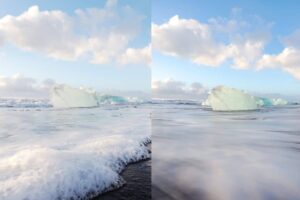Beyond the Lens: Exploring the World of Long Exposure Photography

Long exposure photography is a captivating technique that goes beyond traditional snapshots, allowing photographers to create mesmerizing images by capturing the passage of time in a single frame. This method involves using a slower shutter speed, typically ranging from a few seconds to several minutes, to capture motion and create a sense of fluidity in the final image.
One of the primary subjects for long exposure photography is water. Whether it’s a serene lake, a rushing river, or crashing ocean waves, the extended exposure time blurs the movement of the water, transforming it into a silky, ethereal substance. This effect can add a dreamlike quality to the image, turning an ordinary scene into a work of art. To achieve this, photographers often use neutral density filters to reduce the amount of light entering the camera, allowing for longer exposure times without overexposing the image.
Cityscapes at night also provide fantastic opportunities for long exposure photography. The streaks of light created by moving cars and the glow of city lights can be transformed into dynamic and vibrant compositions. Photographers may choose iconic landmarks or busy intersections, using extended exposure times to capture the bustling energy of urban life in a single frame.
Another intriguing aspect of long exposure photography is its ability to convey the passage of time in a static scene. For example, photographing star trails during a clear night can result in stunning images that reveal the Earth’s rotation over time. This technique requires patience and a sturdy tripod to keep the camera steady throughout the extended exposure.
Mastering long exposure photography involves a combination of technical skill and artistic vision. Understanding the relationship between shutter speed, aperture, and ISO is crucial, as these settings play a significant role in achieving the desired effect. Experimentation is key, as different scenes and subjects may require adjustments to these settings to achieve the best results.
In conclusion, long exposure photography opens up a world of creative possibilities, allowing photographers to explore the fluidity of time and capture scenes in a unique and captivating way. Whether it’s the soft flow of water, the dynamic energy of a city at night, or the celestial dance of stars, this technique adds a magical touch to ordinary scenes, transforming them into extraordinary works of art.



 Choose the Right Focal Length: Experiment with different focal lengths to find the most effective perspective for your landscape. Wide-angle lenses are popular for capturing expansive scenes, while telephoto lenses can isolate specific elements and compress the perspective, adding depth to your compositions.
Choose the Right Focal Length: Experiment with different focal lengths to find the most effective perspective for your landscape. Wide-angle lenses are popular for capturing expansive scenes, while telephoto lenses can isolate specific elements and compress the perspective, adding depth to your compositions.
